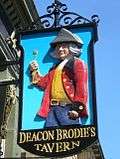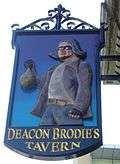William Brodie

William Brodie (28 September 1741 – 1 October 1788), more commonly known by his prestigious title of Deacon Brodie, was a Scottish cabinet-maker, deacon of a trades guild, and Edinburgh city councillor, who maintained a secret life as a burglar, partly for the thrill, and partly to fund his gambling.
Career
By day, Brodie was a respectable tradesman and Deacon (president) of the Incorporation of Wrights, the head of the Craft of Cabinetmaking, which made him a member of the Town Council. Part of his job in building cabinets was to install and repair their locks and other security mechanisms and repair door locks. He socialised with the gentry of Edinburgh, and met the poet Robert Burns and the painter Sir Henry Raeburn. He was a member of the Edinburgh Cape Club[1] and was also known as "Sir Llyud".
At night, however, Brodie became a burglar and thief. He used his daytime job as a way to gain knowledge about the security mechanisms of his clients and to copy their keys using wax impressions. As the foremost lockwright of the city, Brodie was asked to work in the houses of many of the richest members of Edinburgh society. He used the money he made dishonestly to maintain his second life, which included a gambling habit and two children to five mistresses (who did not know of each other, and were unknown in the city). He reputedly began his criminal career around 1768, when he copied keys to a bank door and stole £800, then enough to maintain a household for several years. In 1786 he recruited a gang of three thieves, John Brown (a thief escaping a seven-year sentence of transportation), George Smith (a locksmith who ran a grocer's shop in the Cowgate) and Andrew Ainslie (a shoemaker).
Capture and trial

The case that led to Brodie's downfall began later in 1788 when he organised an armed raid on an Excise office in Chessel's Court on the Canongate. Brodie's plan failed. On the same night, Brown approached the authorities to claim a King's Pardon, which had been offered after a previous robbery, and gave up the names of Smith and Ainslie (initially saying nothing of Brodie's involvement). Smith and Ainslie were arrested and the next day Brodie attempted to visit them in prison but was refused. Realising that he had to leave Edinburgh, Brodie escaped to London and then to the Netherlands intending to flee to the United States but was arrested in Amsterdam and shipped back to Edinburgh for trial.
The trial of Brodie and Smith started on 27 August 1788. At first there was no hard evidence against Brodie, although the tools of his criminal trade (copied keys, a disguise and pistols) were found in his house and workshops. But with Brown's evidence and Ainslie being persuaded to turn King's Evidence, added to the self-incriminating lines in the letters he had written while on the run, the jury found Brodie and Smith guilty.
Brodie and Smith were hanged at the Old Tolbooth in the High Street on 1 October 1788, before a crowd of 40,000. According to one tale, Brodie wore a steel collar and silver tube to prevent the hanging from being fatal. It was said that he had bribed the hangman to ignore it and arranged for his body to be removed quickly in the hope that he could later be revived. If so, the plan failed. Brodie was buried in an unmarked grave at the Buccleuch Church in Chapel Street. The ground is now covered by a car park behind university lecture-halls. However, rumours of his being seen in Paris circulated later and gave the story of his scheme to evade death further publicity.
Popular culture
Popular myth holds that Deacon Brodie built the first gallows in Edinburgh and was also its first victim. Of this William Roughead in Classic Crimes states that after research he was sure that although the Deacon may have had some hand in the design, "...it was certainly not of his construction, nor was he the first to benefit by its ingenuity".


Robert Louis Stevenson, whose father owned furniture made by Brodie, wrote a play (with W. E. Henley) entitled Deacon Brodie, or The Double Life, which was unsuccessful. However, Stevenson remained fascinated by the dichotomy between Brodie's respectable façade and his real nature and was inspired to write The Strange Case of Dr. Jekyll and Mr. Hyde (1886).[2]
Deacon Brodie is commemorated by a pub of that name on Edinburgh's Royal Mile, on the corner of the Lawnmarket and Bank Street which leads down to The Mound; and a close off the Royal Mile, which contained his family residence and workshops, still bears the name "Brodie's Close". A pub in New York City carrying his name sits on the south side of the famous west side 46th Street Restaurant Row between 8th Avenue and 9th Avenue.
Jean Brodie from The Prime of Miss Jean Brodie claims to be descended from Deacon Brodie.[3] His double life serves as a metaphor for the duplicity of Miss Brodie, as well as her self imposed demise.
A TV movie of the same name was aired on 8 March 1997 on BBC1. Part of the Screen One season, it starred Billy Connolly and was made in Edinburgh.[4]
References
- ↑ Deacon Brodie of Edinburgh and Edinburgh Cape Club, Google books
- ↑ Oslin, Reid (15 March 2001). "Jekyll and Hyde: The Real Story". Boston College Chronicle.
- ↑ Template:Muriel Spark, The Prime Of Miss Jean Brodie page 88
- ↑ Deacon Brodie at the Internet Movie Database
Further reading
- Hutchison, David (2014). Deacon Brodie: A Double Life. ISBN 9781512175172
- Gibson, John Sibbald (1993) [1977]. Deacon Brodie: Father to Jekyll and Hyde. Saltire Society. ISBN 0-904505-24-3
- Bramble, Forbes (1975). The Strange Case of Deacon Brodie. London: Hamish Hamilton. ISBN 978-0-241-89292-3
- Roughead, William (1906) The Trial of Deacon Brodie (Notable Scottish Trials series).